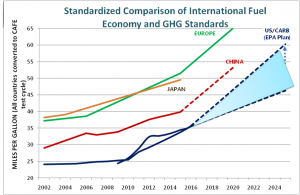Sun 13 Feb 2011
Energy and Environment: China’s Year of the Tiger in Numbers
Posted by Lucia Green-Weiskel under Uncategorized1 Comment
By Lucia Green-Weiskel
As China bids farewell to the Year of the Tiger and rings in the Year of the Rabbit this month many Americans are wondering: Is China eclipsing the US and taking over as the world’s new superpower? In last year’s midterm election, 29 candidates (from both parties) were afraid that was the case. Each one included anti-China messages in advertising campaigns claiming that their opponents were too timid against a menacing and rising China. Glenn Beck thinks China will overtake the US to become the largest economy in the next decade and we should be very afraid. Coming on the heels of his state summit with Chinese president Hu Jintao, Obama’s State of the Union address was full of implicit and explicit China comparisons. “China is building faster trains and newer airports,” he said. “Meanwhile, when our own engineers graded our nation’s infrastructure, they gave us a ‘D.’” One particular area where China is steaming ahead is energy. Thomas Friedman and Energy Secretary Steve Chu have both referenced a new Sputnik moment, drawing a comparison between today’s US-China clean technology race and the notorious US-Soviet space race of the Cold War.
On the energy and technology front, what has China been up to in the last year? What follows is a list of China’s achievements in the Year of the Tiger, in numbers:
Breaking World Records:
In the last year, China:
— overtook the US as the world’s largest car market (this actually happened in late 2009).
— overtook Germany to become the world’s largest exporter.
— overtook Japan to become the world’s No. 2 economy.
— built a passenger bullet train that set a new record hitting 302 mph.
— built the world’s longest bridge over water.
— held foreign exchange reserves that hit a world record in 2010 at $2.5 trillion.
— set a record when the Agricultural Bank of China IPO hit $22.1 billion in July.
Selling Stuff:
In keeping with past years, China sold a lot of stuff in the Year of the Tiger. China’s role as the “factory of the world” has catapulted it to the top as both the world’s largest energy consumer and emitter of greenhouse gases (although this has been true since 2006, China only admitted it last year.) With just 20% of the world’s population, China sold:
95% of the world’s rare earths (used to make electronics).
90% of the vitamin C consumed in the US and 70% of the world’s penicillin.
80% of the world’s laptops (including Taiwan).
75% of the world’s garlic supply.
70% of the world’s light bulbs, toys and footwear.
70% of the world’s metal lighters come from one city, Wenzhou.
70% of the world’s violins.
70% of the world’s sex toys.
60% of the world’s neckties are made in Zhejiang province.
55% of the world’s solar panels.
50% of the world’s wind turbines.
50% of the world’s cameras.
44% of the world’s cement.
40% of the world’s coal (but accounts for 80% of the world’s coal mining related fatalities).
30% of the world’s air conditioners and televisions.
25% of the world’s washing machines.
and Chinese vehicle sale grew by 40% to reach 17 million units.
It is important to look at these numbers in context. Although China is the largest energy consumer and emitter of greenhouse gases, it has a much smaller energy footprint on a per capita and an historic basis. One American consumes five times the energy of one Chinese. Although China is emitting greenhouse gases at a faster rate today, a great majority of the emissions in the air are the result of the American and European industrial revolutions. Finally, nearly one-quarter of China’s greenhouse gas emissions are directly sourced to products that are exported to the West.
Setting Ambitious Policies:
In the last year, China launched a set of ambitious carbon-reducing policies, which if implemented, could amount to the greatest carbon avoidance in the world. The 12th Five Year Plan (covering 2011-2015) will include a reiteration and formal commitment to reduce the energy intensity of the Chinese economy by 40%-45% from 2005 levels by 2020. The plan also includes measures to increase reliance on renewable energy. Some officials have claimed renewable sources could make up 20% of China’s total energy use (that number does not include nuclear energy). The US and China are neck-and-neck on electric vehicles. Both countries have pledged to have one million EVs on the road in the next decade (see here and here). The table below shows key projects and the tonnage of carbon equivalent that was saved as a result of the energy savings goals in the 11th Five Year Plan (2006-2010).
Source: LBNL estimates and calculations based on National Development and Reform Commission (NRDC), 2006. Implementation Suggestions of Ten Key Energy-Conservation Projects during the Eleventh Five-Year Plan, NDRC Department of Resource Conservation and Environmental Protection Document #: [2006] 1457. Accessed on Feb. 14 at www.chinafaqs.org/library/chinafaqs-chinas-ten-key-energy-efficiency-projects
Under the 12th Five Year Plan, China will begin to implement a national cap-and-trade program for greenhouse gases, something that was a high priority during the Obama presidential campaign, but which has turned into a political flop in Washington. And there are hundreds of new standards and regulations put into effect every month in Beijing to increase the energy efficiency of appliances, buildings, fuels and vehicles. For example, below is a chart of fuel economy standards for vehicles in different regions around the world. China ranks below the EU and Japan, but ahead of the US and Canada.
Source: Dr. Feng An, Innovation Center for Energy and Transportation, ©2011.
All this must be taken with a pinch of salt. While China is encroaching on the US in key technological areas, it is far from unseating the world’s superpower. Other key indicators demonstrate this. For example, China’s military is Lilliputian compared with the US. Last year China’s military budget was $77.97 billion, less than one-eighth of the US’s $663.8 billion budget. And the US economy still towers over the world: US nominal GDP in 2010 was $14.62 trillion to China’s $5.76 trillion.
China remains firmly in the category of a “developing” country. With a population five times larger than the US, per capita GDP (PPP) was $7,400 in 2010 ranking it 127th in the world according to the CIA World Fact Book (the same GDP measurement for the US was $47,400, the 10th highest in the world). While 76.7% of the US GDP comes from the service sector, over half (56.4%) of the GDP in China comes from industry and agriculture. The lesson here is that while China is making big strides, it is still a developing economy and far behind the US in key areas. China might have the fastest computer, but it is one of the only countries in the world which still manufactures the ox-drawn plow.




February 13th, 2011 at 4:32 pm
[…] This post was mentioned on Twitter by CUNYAcademicCommons, EarthAdapt. EarthAdapt said: #Green #Energy : A fast-changing world: The politics of energy, climate change and … http://bit.ly/ghzGdu ; ) EarthAdapt.com […]